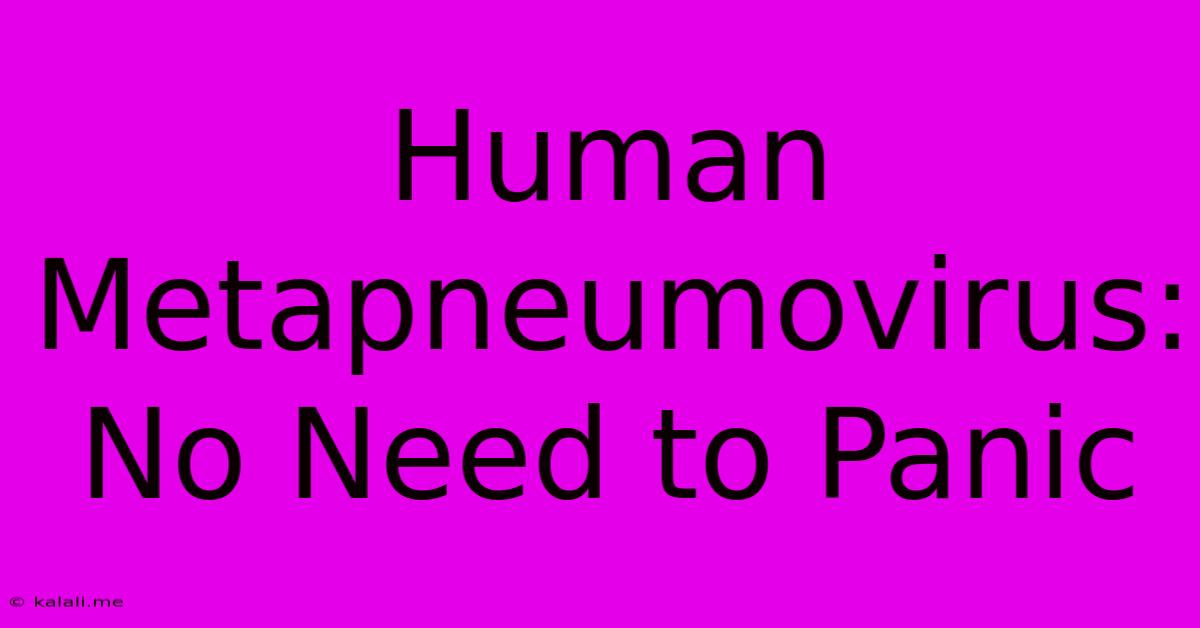Human Metapneumovirus: No Need To Panic
Kalali
Jan 10, 2025 · 4 min read

Table of Contents
Human Metapneumovirus: No Need to Panic
Human metapneumovirus (hMPV) is a common respiratory virus that causes infections similar to the common cold or influenza. While it can be unpleasant, especially for young children and older adults, understanding hMPV helps alleviate unnecessary anxiety. This article aims to demystify hMPV, outlining its symptoms, transmission, treatment, and prevention, emphasizing that while vigilance is important, panic is not necessary.
Understanding Human Metapneumovirus (hMPV)
hMPV is a virus belonging to the Paramyxoviridae family, closely related to respiratory syncytial virus (RSV). It's a significant cause of respiratory illnesses worldwide, particularly in infants, young children, and the elderly. Unlike some viruses, hMPV wasn't discovered until 2001, meaning initial research and understanding lagged behind other common respiratory viruses. This late discovery contributed to some initial anxieties surrounding the virus.
How is hMPV spread?
hMPV spreads through the same mechanisms as many other respiratory viruses:
- Respiratory droplets: When an infected person coughs or sneezes, tiny droplets containing the virus are released into the air. These droplets can be inhaled by others nearby.
- Contact transmission: The virus can also spread through contact with contaminated surfaces. Touching a surface with the virus on it and then touching your eyes, nose, or mouth can lead to infection.
This means that hMPV spreads most easily in close-contact settings, such as schools, daycare centers, and families. Good hygiene practices are vital in reducing the risk of transmission.
hMPV Symptoms: Recognizing the Illness
Symptoms of hMPV infection are generally mild and similar to those of the common cold or influenza. They typically appear 3-5 days after infection and may include:
- Runny nose: Often a clear nasal discharge that may later become thicker.
- Cough: Usually a dry cough initially, which may become more productive (producing mucus) as the illness progresses.
- Sore throat: A scratchy or painful throat is a common symptom.
- Fever: A low-grade fever is possible, but not always present.
- Headache: Mild headaches can occur.
- Muscle aches: Some individuals may experience muscle aches or body pains.
- Wheezing (in infants and young children): Wheezing is a particularly concerning symptom in young children and may indicate more severe lower respiratory tract involvement. This warrants immediate medical attention.
- Breathing difficulties: Shortness of breath or difficulty breathing is a serious symptom requiring prompt medical care.
Important Note: While most cases of hMPV are mild and self-limiting, it's crucial to seek medical attention if you or your child experiences severe symptoms such as difficulty breathing, persistent high fever, or worsening symptoms.
hMPV Treatment and Management
There is no specific antiviral treatment for hMPV. Treatment focuses on managing symptoms and providing supportive care. This typically involves:
- Rest: Getting plenty of rest helps the body fight off the infection.
- Hydration: Drinking plenty of fluids helps prevent dehydration.
- Over-the-counter medications: Over-the-counter pain relievers (such as acetaminophen or ibuprofen) can help reduce fever and relieve aches and pains. Always follow the recommended dosage instructions carefully. Decongestants and cough suppressants may provide some relief, but their effectiveness is debated.
- Humidifier: Using a humidifier can help relieve nasal congestion.
- Monitoring: Closely monitor symptoms and seek medical attention if they worsen.
For infants, young children, and individuals with underlying health conditions, hospitalization might be necessary to provide respiratory support. This is especially important in cases of severe lower respiratory tract infection.
Preventing the Spread of hMPV
Prevention strategies for hMPV are similar to those for other respiratory viruses:
- Frequent handwashing: Washing your hands frequently with soap and water for at least 20 seconds, especially after coughing, sneezing, or touching surfaces, is crucial.
- Avoiding close contact: Avoid close contact with individuals who are sick.
- Covering coughs and sneezes: Cover your coughs and sneezes with a tissue or your elbow.
- Disinfecting surfaces: Regularly disinfect frequently touched surfaces, such as doorknobs and light switches.
- Staying home when sick: Stay home from work or school if you are sick to prevent spreading the virus to others.
- Vaccination: Currently, there isn't a widely available vaccine specifically for hMPV. However, researchers are actively working on developing effective vaccines.
hMPV: Perspective and Calm
While hMPV can cause significant illness, especially in vulnerable populations, it's vital to maintain perspective. The vast majority of hMPV infections are mild and resolve without complications. Understanding the virus, its transmission, symptoms, and prevention strategies empowers individuals to take appropriate precautions and manage infections effectively. Panicking serves no purpose; informed action does. By following simple hygiene practices and seeking medical advice when necessary, you can significantly reduce the risk of infection and manage symptoms effectively. Focus on preventative measures and trust in the body's natural defenses to combat this common respiratory virus. Remember, staying informed is key, but unnecessary fear only hinders effective management.
Latest Posts
Latest Posts
-
How Long Does It Take To Drive 2000 Miles
Jul 18, 2025
-
How Many Grams In A Teaspoon Of Cinnamon
Jul 18, 2025
-
How Long To Heat Water In Microwave
Jul 18, 2025
-
40 Oz Of Water Is How Many Cups
Jul 18, 2025
-
How Many Eighths In A Quarter Pound
Jul 18, 2025
Related Post
Thank you for visiting our website which covers about Human Metapneumovirus: No Need To Panic . We hope the information provided has been useful to you. Feel free to contact us if you have any questions or need further assistance. See you next time and don't miss to bookmark.